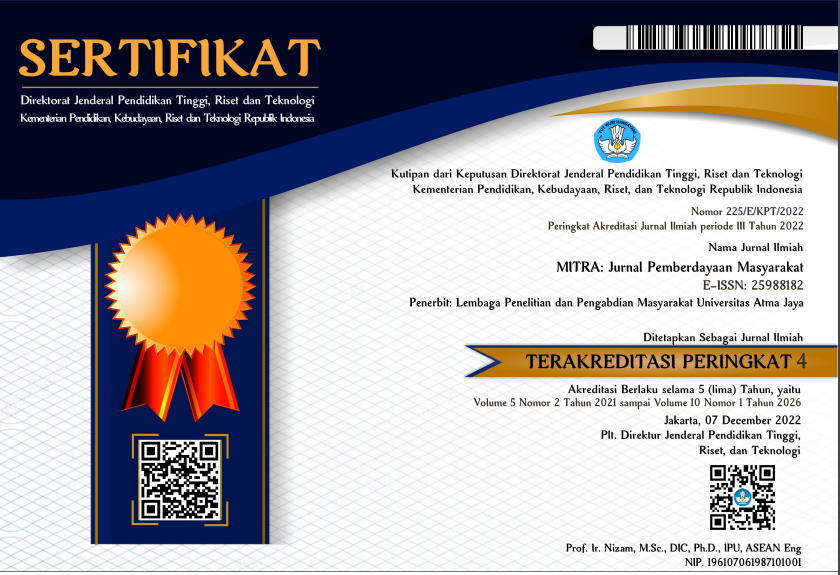Efforts in Reducing the Urge of Using Gadgets among Vocational High School Students
DOI:
https://doi.org/10.25170/mitra.v4i1.1108Kata Kunci:
gadget, teacher; principal, school, studentAbstrak
The role of vocational high schools in producing reliable workforce is highly expected. Gadgets are one of the tools used by vocational high school students in their daily lives. Gadgets can help in the learning process. However, there are indications that students tend to overuse gadgets. This overuse has caused problems, for example, in their social relationship. Efforts to reduce the use of gadgets are therefore needed so that the students are able to improve their skills in building a social relationship. This community service activity was intended to reduce the urge to use gadgets by students in their daily lives. The activity was divided into two parts. The first part included discussion with the principal and a teacher and the second part discussion with students. The participants of the activity were the school principal, a teacher, and 36 students of the vocational high school in Belitung. Interactive group discussions were used as the method in this program. In addition, a questionnaire was used to obtain a description of students’ experiences and their opinions about the time of using gadgets. The activity resulted in the decision made by the principal and the teacher to implement a plan to reduce the urge of using gadgets by students while at school. Students also tended to agree on reducing the urge to use gadgets. However, the maximum duration of time per day for students to be able to use gadgets still needed further discussion, because students inclined to disagree with the limit of three hours per day. From this activity it was concluded that the interactive discussions among researcher, principal, teacher, and students could reduce the urge to use gadgets by students while at school.
Referensi
Bandura, A. (1971). Social learning theory. New York, NY: General Learning Press.
Davis, F. D. (1989). Perceived usefulness, perceived ease of use, and user acceptance of information technology. MIS Quarterly, 13(3), 319-340. https://doi.org/10.2307/249008.
Fishbein, M., & Ajzen, I. (1975). Beliefs, attitude, intention, and behavior: An introduction to theory and research. Reading, MA: Addison-Wesley.
Jap, T., Tiatri, S., Jaya, E.S., & Suteja, M.S. (2013). The development of Indonesian online game addiction questionnaire. Plos One, 8(4), 1-6. Diunduh dari https://doi.org/10.1371/ journal.pone.0061098.
Jap, T. (2017). The Technology Acceptance Model of Online Game in Indonesian Adolescents. Makara Hubs-Asia, 21(1), 24-31, doi: 10.7454/mssh.v2 l i l.3497
Joo, J., Sang, Y. (2013). Exploring Koreans’ smartphone usage: An integrated model of the technology acceptance model and uses and gratifications theory, Elsevier, 25122518. Diunduh dari http://dx.doi.org/10.1016/j.chb.2013.06.002.
Kamberelis, G., Dimitriadis, G., Welker, A. (2018). Focus group research and/in figured worlds. In Denzin, N. K. & Lincoln, Y.S (Eds.) The Sage handbook of qualitative research (5th ed.). Singapore: Sage.
Karadag, E., Tosuntas, S. B., Erzen, E., Duru, P., et al. (2016). The virtual world’s current addiction: Phubbing. The Turkish Journal on Addictions, 3(2), 250-269 10.15805/addicta.2016.3.0013.
Lee, Y., Chang, C., Lin, Y., & Cheng, Z. (2014). The dark side of smartphone usage: Psychological traits, compulsive behavior and technostress. Elsevier, 31, 373– 383. doi:10.1016/j.chb.2013.10.047.
Na, J.U., Lee, T.R., Kang, M.J., Shin, T.G., Sim, M.S., Jo, I.J., Song, K.J., & Jeong, Y.K. (2014). Basic life support skill improvement with newly designed renewal programme: cluster randomised study of small-group-discussion method versus practice-while-watching method. Emergency Medicine Journal, 31(12), 964-969. https://emj.bmj.com/content/31/12/964.
Nyumba, T. O., Wilson, K., Derrick, C. J., & Mukherjee, N. (2018). The use of focus group discussion methodology: Insights from two decades of application in conservation. Methods in Ecology and Evolution, 9(1),20–32. https://doi.org/10.1111/2041210X.12860.
Rosen, C. (2004). Our cell phones, ourselves. The New Atlantis - A Journal of Technology and Society, 6, 26-45.
Venkatesh, V. & Davis, F. D. (2000). A theoretical extension of the technology acceptance model: four longitudinal field studies. Management Science, 46(2), 186-204, Diunduh dari https://www.jstor.org/stable/2634758.
Wong, L. P. (2008). Focus group discussion: A tool for health and medical research. Singapore Medical Journal, 49(3), 256–261.
Wu, C.-Y., Lin, Y.-Y., Yeh, M. C., Huang, L.-H., Chen, S.-J., Liao, S.-C., & Lee, M.-B. (2014). Effectiveness of interactive discussion group in suicide risk assessment among general nurses in Taiwan: A randomized controlled trial. Nurse Education Today, 34(11), 1388–1394. doi:10.1016/j.nedt.2014.03.015 .
Unduhan
Diterbitkan
Cara Mengutip
Terbitan
Bagian
Lisensi
This license allows reusers to distribute, remix, adapt, and build upon the material in any medium or format for noncommercial purposes only, and only so long as attribution is given to the creator. If you remix, adapt, or build upon the material, you must license the modified material under identical terms.







_.jpeg)




.png)
2.png)
.png)
.png)



